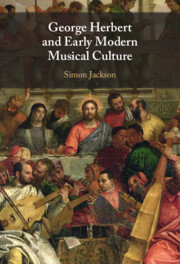Book contents
- George Herbert and Early Modern Musical Culture
- George Herbert and Early Modern Musical Culture
- Copyright page
- Dedication
- Contents
- Figures
- Musical Examples
- Preface
- Acknowledgements
- Introduction
- Chapter 1 Measuring Well
- Chapter 2 Communities of Voices
- Chapter 3 The Visual Music of the Masque
- Chapter 4 Concord and Consent
- Chapter 5 Double Motion
- Chapter 6 Singing the Psalms
- Epilogue
- Notes
- Bibliography
- Index
Epilogue
Published online by Cambridge University Press: 11 November 2022
- George Herbert and Early Modern Musical Culture
- George Herbert and Early Modern Musical Culture
- Copyright page
- Dedication
- Contents
- Figures
- Musical Examples
- Preface
- Acknowledgements
- Introduction
- Chapter 1 Measuring Well
- Chapter 2 Communities of Voices
- Chapter 3 The Visual Music of the Masque
- Chapter 4 Concord and Consent
- Chapter 5 Double Motion
- Chapter 6 Singing the Psalms
- Epilogue
- Notes
- Bibliography
- Index
Summary
The importance of Herbert’s musico-poetic activities for an understanding of his devotional verse is summarised, transforming our reading of his verse and challenging us to think beyond a silent encounter with the written page. At the heart of Herbert’s music lies the tension of paradox: between abstract ideal and the imperfect reality of the world; between simple expression and more elaborate, ornamented modes; between the evanescent temporality of earthly existence and the eternity of God’s time. In conclusion, the Epilogue turns to the work of Herbert’s twentieth-century reader Simone Weil, who like Herbert recognises the paradoxical tension of music, what she calls ‘Harmony in the Pythagorean sense; the just balance of contraries’.
- Type
- Chapter
- Information
- George Herbert and Early Modern Musical Culture , pp. 204 - 208Publisher: Cambridge University PressPrint publication year: 2022

